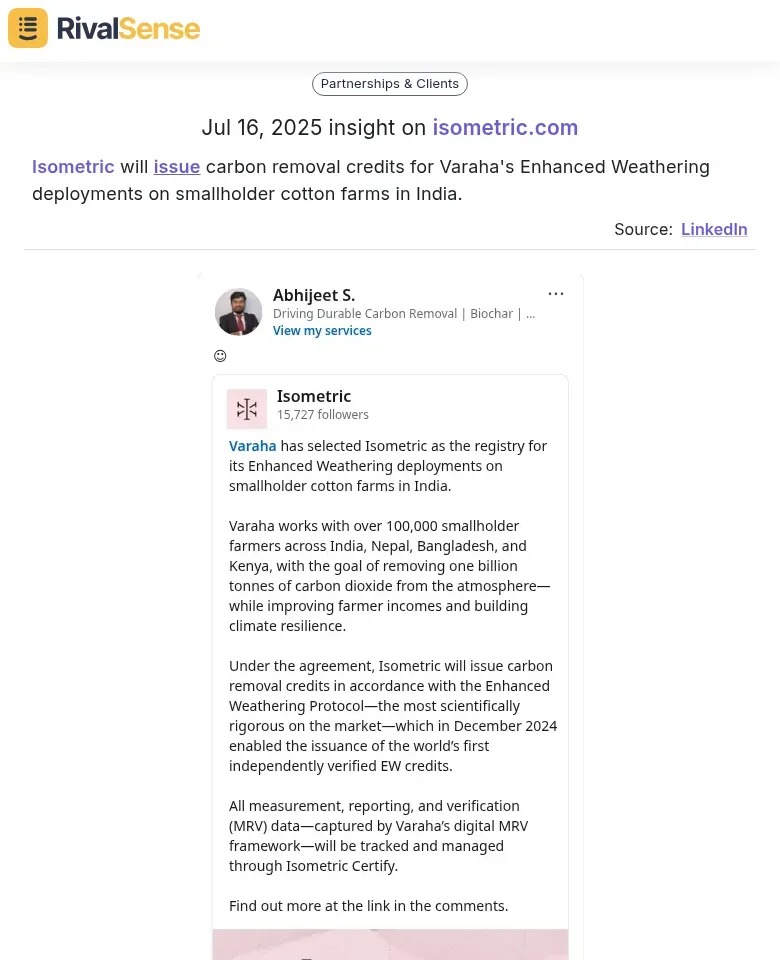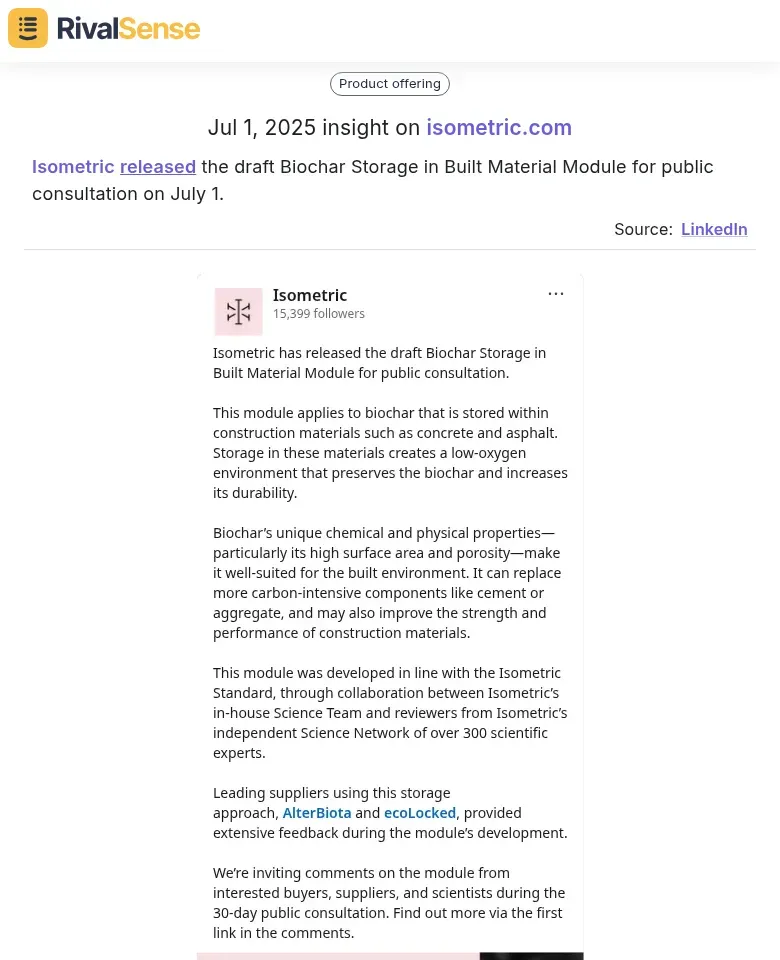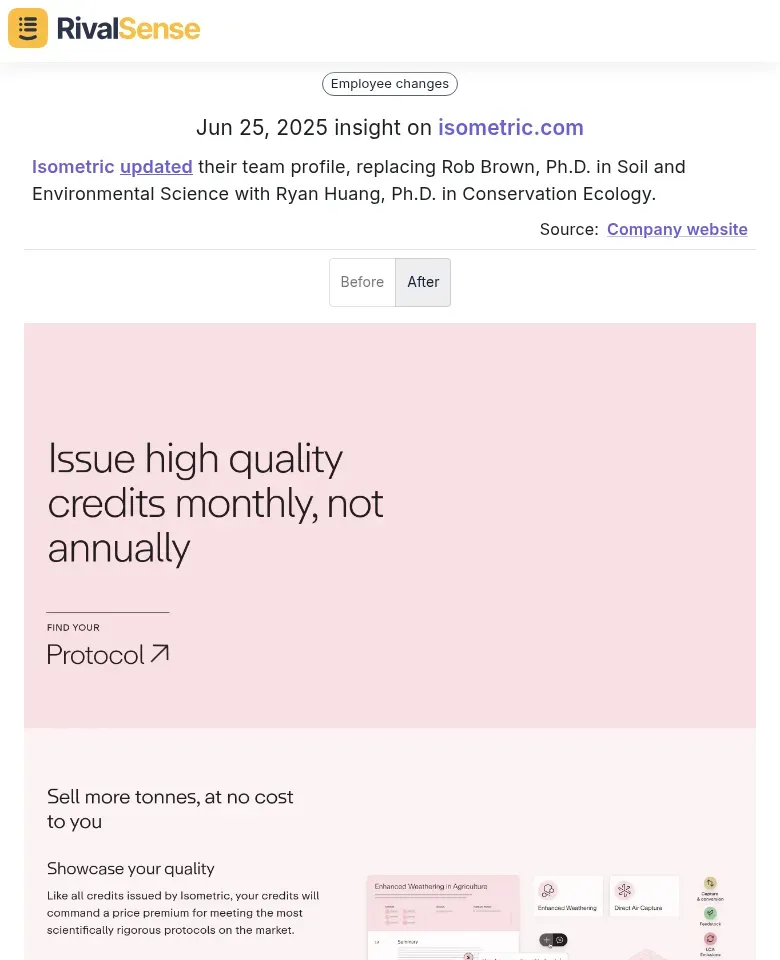Step-by-Step: Track Carbon Removal Competitor Innovation Strategies
The carbon removal industry is experiencing unprecedented growth, with market valuations projected to reach $100+ billion by 2030. This explosive expansion creates a landscape where competitive advantages can emerge overnight through breakthrough technologies, strategic partnerships, or regulatory positioning.
For B2B leaders in this space, competitor intelligence isn't just helpful—it's essential for survival. Companies that systematically track competitor moves gain crucial advantages:
Early Market Signal Detection: Monitor competitor patent filings, partnership announcements, and pilot program launches to identify emerging business models before they scale. Set up Google Alerts for key competitor names plus terms like "partnership," "funding," or "pilot."
Regulatory Preparedness: Track how competitors respond to evolving carbon credit standards and compliance requirements. This intelligence helps you anticipate regulatory shifts and position your offerings accordingly.
Strategic Partnership Mapping: Analyze competitor alliance networks to identify potential partners, suppliers, or acquisition targets before markets become saturated.
Quick Action Checklist:
- ✅ Create competitor monitoring dashboards for top 5-10 rivals
- ✅ Track competitor job postings to understand strategic hiring priorities
- ✅ Monitor competitor content strategies and messaging evolution
- ✅ Set up automated alerts for competitor news and announcements
- ✅ Analyze competitor pricing models and customer case studies
Without systematic competitor tracking, you're essentially flying blind in a market where first-mover advantages and strategic positioning determine long-term success. The companies that master competitive intelligence today will dominate tomorrow's carbon removal landscape.
🔍 Tracking Partnership and Credit Issuance Strategies
Strategic alliances reshape market dynamics in carbon removal. Monitoring partnership structures and credit operations reveals critical insights into competitors' expansion tactics and revenue models.
For example, tracking joint credit issuance initiatives helps anticipate market saturation risks:
Isometric issuing carbon removal credits for Varaha's deployments signals market expansion into agricultural carbon solutions. Spotting such alliances early helps identify underserved niches.
Partnership Intelligence Checklist:
• 🔔 Set up alerts for competitor names + "partnership," "collaboration," "joint venture"
• 📰 Monitor press releases and LinkedIn announcements monthly
• 🔬 Track technology provider relationships through patent filings
• 🌍 Analyze project developer partnerships via credit registries (Verra/Gold Standard)
Geographic Expansion Analysis:
Map competitor market entry patterns by tracking:
- 🏢 Regional office openings
- 📜 Local regulatory filings
- 📍 Project locations
- 🤝 Regional partnerships
Tip: Use LinkedIn's advanced search to identify new regional hires—often signaling expansion 6-12 months before announcements.
Credit Methodology Tracking:
Monitor validation approaches by:
- 📑 Reviewing project documentation
- 🔍 Analyzing verification partnerships
- ⚖️ Tracking emerging standards adoption
- 📊 Comparing MRV technology choices
🧪 Monitoring Product Development and Methodology Updates
Innovation cycles accelerate competitive advantages in carbon removal. Tracking R&D pipelines helps anticipate market shifts and benchmark your own development timelines.
Public consultations reveal strategic priorities before formal launches:
Isometric's draft Biochar Storage Module release for consultation signals focus on construction materials. Monitoring such updates allows timely R&D adjustments to counter emerging solutions.
Track Measurement & Verification (MRV) Development:
- 🔔 Alerts for "[competitor] + MRV"
- 📑 Quarterly patent monitoring (USPTO/WIPO)
- 👥 Key R&D personnel LinkedIn tracking
- 📚 Technical publication subscriptions
Monitor Regulatory Engagement:
- 💬 Public comment submissions
- 📝 Consultation responses (ICVCM/Verra)
- 🌐 Standard-setting participation
- 🤝 Verification body partnerships
Identify Emerging Pathways:
- 🗺️ Technology matrices comparing DAC/BECCS/biochar
- 💰 Funding announcement tracking
- 🎓 Academic collaboration analysis
- 👔 Technical job posting reviews
Pro Tips:
- ⚡ Automate tracking with monitoring tools
- 📅 Quarterly innovation comparison reports
- 🕒 Focus on early signals (12-18 month lead time)
👥 Analyzing Team Changes and Expertise Shifts
Personnel movements reveal strategic intentions before public announcements. Tracking expertise shifts provides early warnings about technology pivots or market expansions.
Key personnel replacements often indicate redirection of R&D focus:
Isometric replacing a Soil Science PhD with Conservation Ecology expertise signals strategic emphasis shift. Such changes help anticipate competitors' capability development 6+ months in advance.
Key Monitoring Areas:
- 👑 Leadership transitions
- 🔧 Technical talent acquisition
- 🧠 Advisory board additions
Practical Tracking Steps:
- 🔔 LinkedIn alerts for companies/key personnel
- 👀 Industry job board monitoring
- 📜 Patent inventor tracking
- 🎤 Conference speaker analysis
Analysis Framework:
✓ ⏱️ Timing patterns → strategic priorities
✓ 🎯 Expertise clustering → focus areas
✓ 🌍 Geographic hiring → market expansion
✓ 🎯 Competitive poaching → capability targets
Red Flag Indicators:
- ⚠️ Ex-regulatory officials joining
- ⚠️ Serial entrepreneurs in leadership
- ⚠️ Cross-industry experts
🛠️ Building Your Carbon Removal Competitor Tracking System
Effective intelligence requires systematic monitoring frameworks. Automating data collection frees strategic bandwidth for analysis rather than manual searching. Begin by establishing multi-channel surveillance.
Step 1: Set Up Automated Monitoring
Create Google Alerts for competitor names + keywords ("funding", "methodology", "pilot"). Monitor SEC filings via EDGAR for public companies. Track LinkedIn company pages for team updates.
Step 2: Intelligence Collection Framework
• Primary Sources: Websites, patents, regulatory docs
• Secondary Sources: Industry reports, conference decks
• Real-time Feeds: Twitter/X, newsletters, carbon platforms
Step 3: Standardized Analysis Template
Capture: technology approach, capacity, partnerships, funding status, approvals. Rate competitors on:
- 🚀 Technological maturity
- 🏆 Market position
- ⚠️ Strategic threats
Step 4: Action Triggers
Define response thresholds for:
- 🤝 New partnerships with target clients
- 💡 Breakthrough tech announcements
- ⚖️ Regulatory approvals
- 💰 Major funding rounds
Pro Tip: Use CUR8/Puro.earth for project registration tracking. Hold monthly intelligence briefings to convert data into decisions.
🚀 Turning Insights into Strategic Advantage
Raw intelligence only creates value when converted to action. Use competitor data to identify positioning gaps and time strategic moves precisely.
Market Positioning & Differentiation
Analyze competitor messaging weaknesses. If rivals emphasize scale, counter with innovation speed or quality. Plot price vs. performance matrices to find whitespace opportunities.
Product & Partnership Strategy
Leverage roadmap intelligence to:
- ⏩ Accelerate development in lagging areas
- 🚫 Avoid oversaturated segments
- 🤝 Secure unexplored partnerships
- 🎯 Time launches against competitor vulnerabilities
Market Consolidation Signals
Track for M&A opportunities:
- 📉 Funding gaps vs. leaders
- 🤝 Technology partnerships hinting at acquisitions
- ⚠️ Regulatory compliance struggles
- 📊 Customer concentration risks
Action Framework:
- 📅 Weekly Reviews: Match new moves to your priorities
- 🔄 Quarterly Pivots: Adjust positioning based on landscape shifts
- 📊 Opportunity Scoring: Rate targets using intelligence metrics
- 🗺️ Partnership Mapping: Identify unsecured alliances
🔍 Ready to Decode Your Competitors?
Manually tracking carbon removal innovations is overwhelming. RivalSense automates competitor monitoring across websites, registries, and global sources—delivering actionable insights in weekly reports.
👉 Get your first competitor intelligence report today: Try RivalSense Free
📚 Read more
👉 Market Entry Competitor Intelligence Cheat Sheet for Business Leaders
👉 Oracle Overtakes SAP in ERP Revenue: Turning Market Shifts into Strategic Wins
👉 Strategic Competitive Positioning: A Complete Guide to Outmaneuvering Your Competition
👉 Telehealth Benchmarking: Actionable Strategies to Outperform Competitors
👉 How Real-Time Product Refresh Alerts Transformed Lawcris' Competitor Strategy



